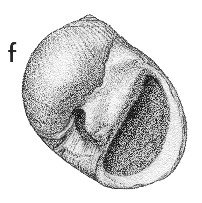
Revised descriptions of New Zealand Cenozoic Mollusca from Beu and Maxwell (1990)

 | Revised descriptions of New Zealand Cenozoic Mollusca from Beu and Maxwell (1990) | 
|
  (Pl. 37f): holotype of Uber waipipiensis Marwick, GS1101, Q22/f7303, Waipipi Shellbeds, Waverley Beach, west of Wanganui, Waipipian (TM5762, GNS) |
Beu & Maxwell (1990): Chapter 14; p. 295; pl. 37 f.
Synonymy: Uber waipipiensis Marwick 1924d, p. 564; Uber pateaensis Marwick 1924d, p. 564; ?Uber ovuloides Marwick 1924d, p. 565; Polinices stanleyi Marwick 1948, p. 30
Classification: Naticidae: Poliniceinae
Description: Large for genus (37-48 mm high), moderately to highly inflated, with low, conic spire and large, regularly convex, enveloping last whorl, large umbilicus, heavy parietal callus, and evenly rounded base, lacking a siphonal canal. Smooth, except for very faint, irregular spiral grooves and fine, irregular growth lines. Aperture D-shaped, with straight inner lip, inclined at an angle of 25° to the coiling axis; callus highly variable in thickness, penetration into umbilicus, and outline of lobe or lobes in umbilicus, but in all specimens having a strongly convex outline at top of parietal area (retracting to suture), an inward inflection followed by a small to moderately large lobe extending at right angle to left just above umbilicus, and another shallow inflection above umbilical lobe. In most specimens, umbilical callus weakly to prominently bilobed. Protoconch not well preserved on any specimens examined, presumably as in P. huttoni, low, of about 2.5 very weakly inflated whorls, not clearly differentiated from teleoconch.
Comparison: The taxonomy of such highly variable Polinices species is poorly understood, but it seems very likely that such forms as P. waipipiensis and P. pateaensis are deeply and shallowly umbilicate variants of one species, as occurs in living tropical Polinices species. P. stanleyi includes more heavily callused forms, but some forms are indistinguishable from P. waipipiensis. P. ovuloides may be a distinct, narrower species living with P. waipipiensis on the South Taranaki coast, but it seems just as likely to be the male form of P. waipipiensis, as living species of Polinices show marked sexual dimorphism. Beu & Maxwell (1990) selected Uber waipipiensis Marwick (1924d, p. 564) as the name to use for the species also named U. waipipiensis Marwick, U. pateaensis Marwick, 1924, and/or U. ovuloides Marwick, 1924.
Although Polinices lives now in Northland (where there is no fossil record), and seems likely to have done so throughout Plio-Pleistocene time, its extinction in central and southern New Zealand at the end of Mangapanian time is an important biostratigraphical marker.
Distribution: Opoitian?; Waipipian-Mangapanian. Waipipi Shellbeds, Waverley Beach, west of Wanganui, Waipipian (type of Uber waipipiensis); mouth of Patea River, South Taranaki, Waipipian (types of both Uber pateaensis and U. ovuloides); Otahuhu Brewery well, Auckland, Waipipian (type of Polinices Stanleyi). Abundant and widespread throughout New Zealand in Pliocene (particularly Waipipian and Mangapanian) rocks of shallow-water, near-shore, soft-bottom facies, usually in shellbeds with diverse assemblages; particularly abundant in Waipipian and Mangapanian shellbeds along the Wanganui-South Taranaki Coast and in the Starborough Formation, Awatere Valley.
Cite this publication as: "A.G. Beu and J.I. Raine (2009). Revised
descriptions of New Zealand Cenozoic Mollusca from Beu and Maxwell (1990). GNS
Science miscellaneous series no. 27."
© GNS Science, 2009
ISBN
978-0-478-19705-1
ISSN 1177-2441
(Included with a PDF facsimile file
copy of New Zealand Geological Survey Paleontological Bulletin 58 in CD version
from: Publications Officer, GNS Science, P.O. Box 30368 Lower Hutt, New
Zealand)